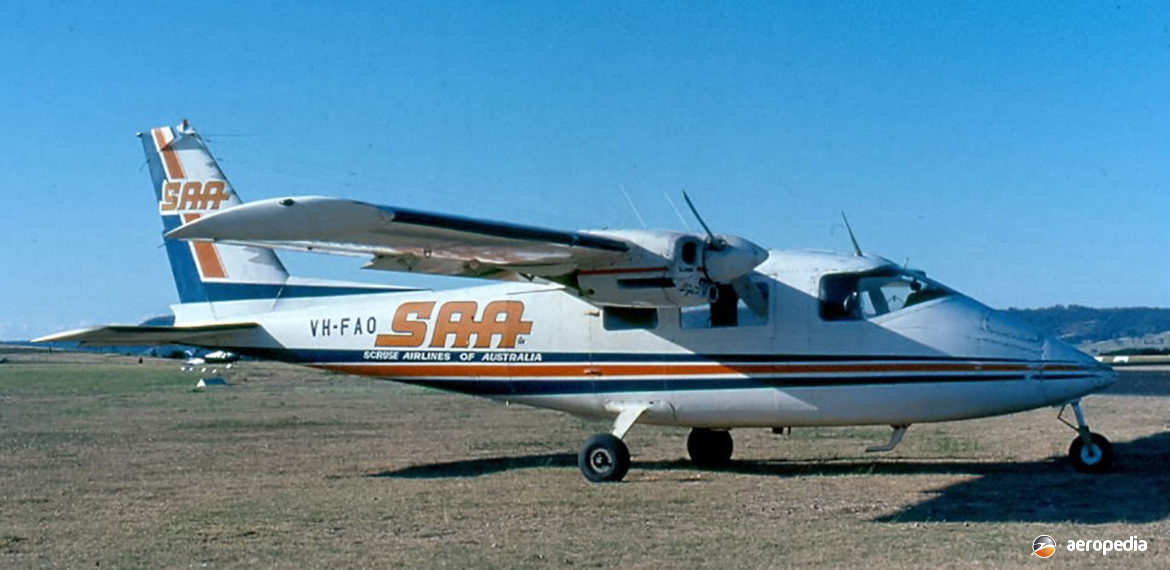Photograph:
Partenavia P-68B VH-FAO (c/n 41) at Maitland, NSW in September 1981 (David C Eyre)
Country of origin:
Italy
Description:
Light utility transport
Power Plant:
Two 149 kw (200 hp) Lycoming IO-360-A1B four-cylinder horizontally-opposed air-cooled engines
Specifications:
- Wingspan: 12 m (39 ft 4½ in)
- Length: 9.35 m (30 ft 8 in)
- Height: 3.4 m (11 ft 2 in)
- Wing area: 18.6 m² (200.2 sq ft)
- Max speed at sea level: 322 km/h (200 mph)
- Cruising speed at 75% power at 1,675 m (5,500 ft: 306 km/h (190 mph)
- Cruising speed at 65% power at 2,745 m (9,000 ft): 296 km/h (184 mph)
- Initial rate of climb: 488 m/min (1,600 ft/min)
- Service ceiling: 6,096 m (20,000 ft)
- Range at 75% power: 1,580 km (982 miles)
- Range at 65% power: 1,700 km (1,056 miles)
- Empty weight: 1,200 kg (2,645 lb)
- Loaded weight: 1,960 kg (4,321 lb)
History:
The P-68 series of light transports was designed by Professor Luigi Pascale and placed in production in Italy by Partenavia in 1972. The prototype (I-TWIN) was flown on 25 May 1970, and this was followed by ten pre-production aircraft, these having a slightly shorter fuselage than the production aircraft, the P-68B, production beginning in 1974. Intended to compete against the light American twins in the light utility transport role, the P-68 was quite successful, with over 60 examples registered in this region over the years. Construction took place at the Partenavia Costozioni Aeronautiche facility in Naples. Nine P-68s were delivered in 1974, 20 in 1975 and 34 in 1976.
Offered with either 134 kw (180 hp) or 149 kw (200 hp) Lycoming engines, and fitted with a fixed tricycle undercarriage, design emphasis was placed on simplicity of construction, ease of maintenance and operation, whilst still possessing a capacity to operate from short and rough fields in the role of air-taxi, light utility transport, and ambulance. In addition, variations included a lengthened eight-seat version; the P-68R with a retractable undercarriage; a floatplane/amphibian version; the P-68TP with Allison 250-B17B turboprops; and the P-68T with turbocharged TIO-360 engines.
First of the type seen in this region was P-68B VH-FSH (c/n 18) ferried to Australia for the local distributor, Forrestair of Essendon, VIC in mid-1974. Further development led to the Model P-68C, with a slightly different nose shape for radar, and turbo-charged engines. The first of this model to be seen in this region was VH-TCU (c/n 239-05TC), a P-68C-TC. A further model also imported to this region was the P-68 Observer, affectionately referred to as the ‘Nosy’ Partenavia. The prototype of this model (D-GERD) was converted from a standard P-68B by Sportavia-Putzer. Fitted with an all-glass nose, it was designed for operations where wide-angle visibility was required and was ideal for spotting fires and floods, shark patrol, search and rescue, or pipeline patrol. In 1982 the West Australian Police Department put an Observer (VH-PGN – c/n 249-05-OB – William G Pense) into service for traffic control, surveillance, search and rescue, and general patrol duties.
The AP-68TP/300 Sparticus was a variant powered by two Allison 250-B17C turboprops each flat rated at 246 kw (330 shp), this model having a max cruising speed at 4,570 m (15,000 ft) of 386 km/h (240 mph). The prototype of this model (I-PAIT) flew for the first time in September 1978. In 1976 a P-68B (I-VICR) was converted to P-68R configuration with a retractable undercarriage. In 1975 a P-68B (F-WVOX) was fitted with floats.
In 1985 a new member of the family was built, known as the Aeritalia-Partenavia AP-68 TP-600 Viator, which was a derivative of the Sparticus using the same engines, wings and tail surfaces but with a 65 cm (25½ in) extension of the fuselage to allow for the installation of two more seats, and a fully retractable undercarriage (dealt with separately). A maritime patrol variant of the Viator was developed for the Guardia di Finanza.
The P-68 was a high-wing monoplane, with the wing being a single-spar torsion-box structure of aluminium alloy, with a fibreglass leading-edge. Eventually Partenavia went into liquidation and was obtained by Samanta, which later became Vulcanair in 1997, returning the P-68 series to production and providing spares for aircraft already in service. At that time the P-68C was in production and was the basic aircraft with two 149 kw (200 hp) Lycoming IO-360-A1B6 engines, but Vulcanair also commenced production of the P-68TC with two 157 kw (210 hp) Textron Lycoming TIO-360-C1A6D engines. Fuel capacity is 269 litres (59.2 Imp gals) in tanks in the wings. Vulcanair later produced a refined variant of the P-68C, an example of this series (VH-VMV) arriving in Australia in late 2004 and initially being used as a demonstrator.

